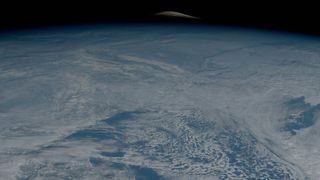Just ahead of a total lunar eclipse, a satellite spotted the curve of the moon floating above our planet.
The Beaver Blood Moon lunar eclipse Tuesday (Nov. 8) will begin at 4:10 a.m. EST (0910 GMT) and will end at approximately 7:49 a.m. EST (1249 GMT) when the moon once again emerges from Earth’s shadow. You can watch the total lunar eclipse on Space.com for free, courtesy of several webcasts from observatories across the United States that start at 3 a.m. EST (0800 GMT).

The refraction of light caused by Earth’s atmosphere distorts the view of the rising moon as seen by the Japanese Himawari weather satellite. (Image credit: Simon Proud / NCEO / Japan Meteorological Agency)
Before that big event, a Japanese satellite spotted something special: the refracted image of the moon hovering just above our planet, thanks the light-bending nature of Earth’s atmosphere.
“This morning, Japan’s #Himawari satellite saw a weird shape above our planet . . . anyone know what it is?” tweeted (opens in new tab) Simon Proud, a research fellow at the National Centre for Earth Observation in the United Kingdom, on Monday (Nov. 7).
Proud, who uses open satellite data like that of Himawari’s to examine climate change, tweeted (opens in new tab) a full picture of the moon just a few minutes later to answer his own question. “Downside of playing this game on Twitter, too many of my followers are experts and know the answer,” he said.
If you are hoping to photograph the moon during Tuesday’s eclipse, check out our guides on how to photograph a lunar eclipse and how to photograph the moon with a camera. You can prepare for your next moon observing session with our guides to the best cameras for astrophotography and best lenses for astrophotography.
If you miss this lunar event, the next total lunar eclipse will occur on March 14, 2025. Partial eclipses will occur in 2023 and 2024. In between eclipse season, note there is a full moon every month, so you can continue to photograph the moon and practice your observing ahead of the next total lunar eclipse.





